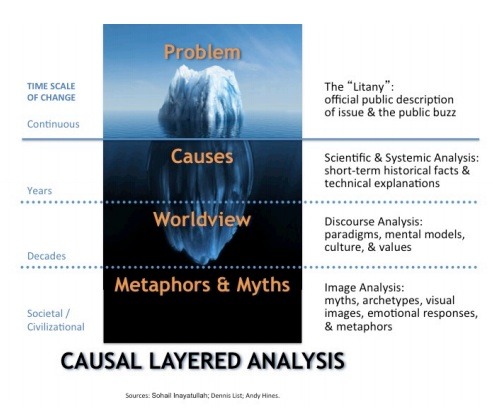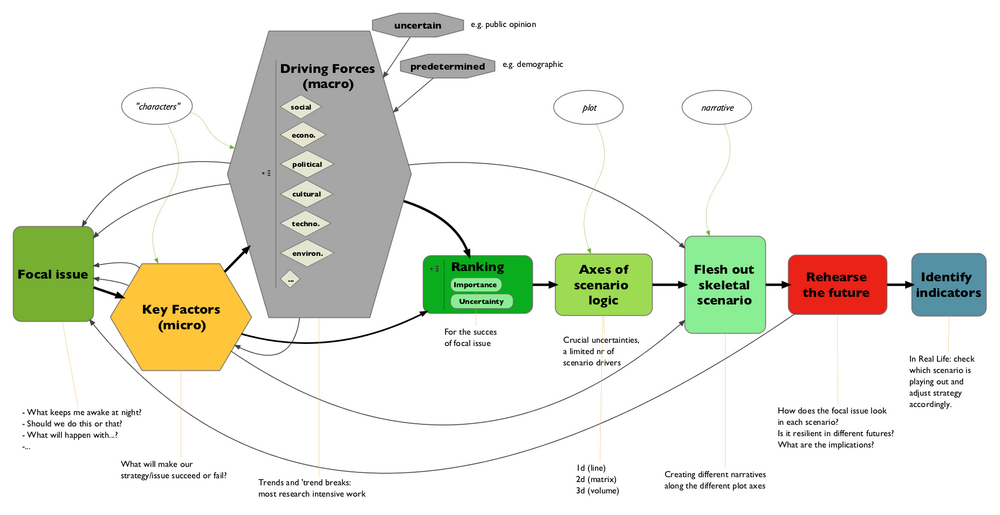Table of Contents
The Art of Futuring
The purpose of futuring is not to predict the future. Instead, futuring is a way to inform your decisions and actions in the present. It allows you to let go of the status-quo and imagine how situations could develop otherwise. Futuring can situate your visions and ideas in the wider contexts in which you operate. Imagining a range of possible futures can help you articulate coherent visions while also developing a capacity to adapt to whatever the future might bring.
To describe the creative process of exploring futures, we use the term 'futuring'. We could have chosen other phrases such as 'future studies', 'speculative design' or 'strategic foresight', but 'to future' as a verb encapsulates the engaged, active attitude that we believe is essential when sending probes into these realms. Futuring can be a complex activity involving many facets, or it can be as simple as telling a story that begins with 'What if…'. The process can be individual but is often a collective, participatory exercise. It tends to work best when different modes of knowing and learning are involved – from analytical to generative and synthesising, rational to somatic, intuitive and interpersonal.
The workshop is designed and facilitated by Maja Kuzmanovic (FoAM), as part of the Futurology of Co-Operation project by Anna Czapski & Diederik Peeters, supported by KASK, SPIN and Kunstenpunt.
Workshop participants: Bilal Alnouri, Hazal Arda, Anna Czapski, Delphine Hesters, Pierre Huyghebaert, Joris Janssens, Heike Langsdorf, Sarah Magnan, Mathilde Maillard, Diederik Peeters, Martina Petrovic, Anna Rispoli, Clara Thomine, Emmanuelle Wattier, Adva Zakai
Workshop schedule
Photo album
Notes from the workshop by Delphine Hesters
Futuring Techniques
The Art of Futuring Workshop offered a hands-on experience of futuring techniques for artists, arts organisations and other members of the cultural proletariat. In addition to mainstream futuring methods like horizon scanning or scenario building, we looked at techniques that are related to (or can be useful for) performing arts. Futuring techniques were introduced through experiential learning. We experimented with techniques for analysing the current situation and emergent signals. We speculated on future scenarios and prototype futures as embodied experiences in the present. We used these experiments to reflect on the futuring methods, on the applicability of futuring in the participants' work and life, and on the need for a more widespread futures literacy in uncertain times.
The conundrum of the Unthinkable and the Unimaginable is everyone’s issue – certainly not just ‘futurists’, nor designers, nor those who happen to have dedicated themselves to political theory or activism; nor just the displaced former residents of New Orleans, nor yet the casualties of Detroit’s seemingly inexorable decline. It is everyone’s problem. Futures studies is a community of thinkers that has defined and directly addressed it as such. But the Great Conversation needs to belong to us all, as do all the discursive technologies, principles of experiential futures design, and other paraphernalia of wiser, ongoing conversation and political self-reinvention. —Stuart Candy, The Futures of Everyday Life
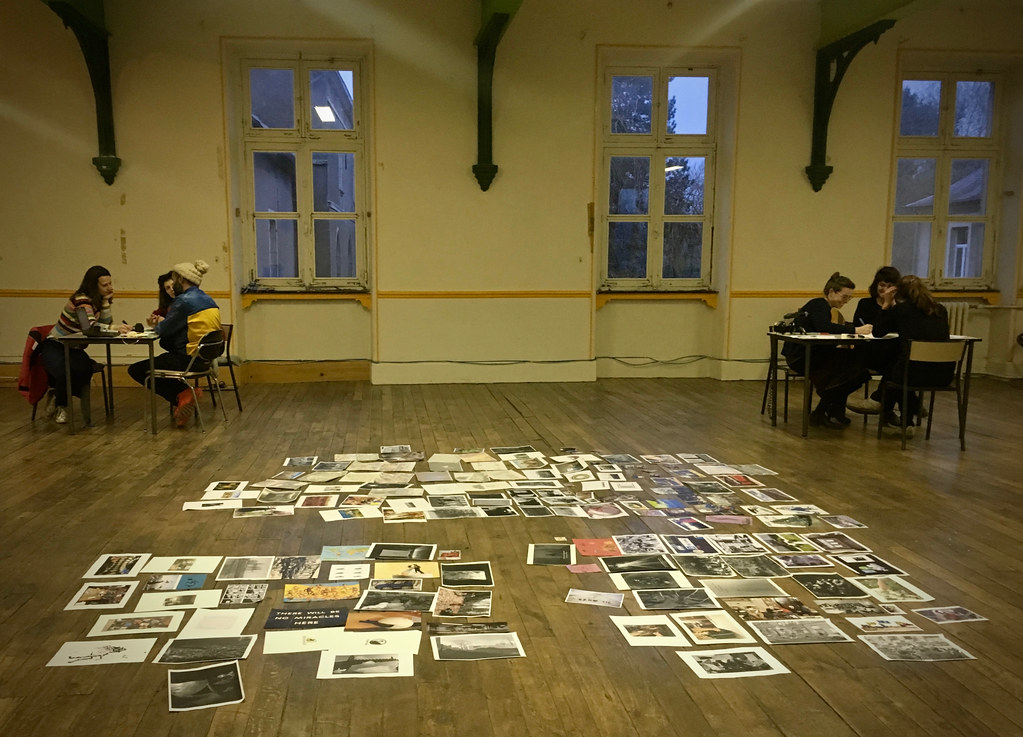
Divination
Divination could be considered as the prehistory of futuring, from the mythical past of futures studies. To honor this lineage, we began the workshop by using a contemporary version of Tarot, to add an element of chance and playfulness in the introduction round. The participants were invited to pick one card from Instant Archetypes from Superflux, describe what they see in the card and speculate on what it might mean for them and their role in the workshop. Instant Archetypes are “a toolkit for anyone looking to open up possibilities, surface questions and untangle stubborn challenges. A reimagining of the timeless tropes of the Major Arcana for the 21st Century where the Fool is now the Consumer, the Chariot is a Drone, and the Moon is a Meme.”
OEmbed Error- All resolution methods failed
Card games
The first session of the workshop introduced a few futuring concepts in a playful setting. By playing card games the participants learned about constraints, wild cards, Four Generic Futures and speculative artefacts
- Reframing the International by Kunstenpunt
- The Thing from the Future by Situation Lab. If the Situation Lab link doesn't work try this link. You can print your own card deck here
Past and present
We’re conditioned to see the present moment as “normal,” with all the banality that implies. This is not a banal moment. It’s the sort of intense, chaotic moment, full of strange things, that we previously only found in science fiction. “Right now” feels like all of science fiction happening at once, and needs to be considered in that context —Warren Ellis
Futuring needs to be grounded in the past and present situation. It is important to understand the context or environment that we wish to explore; to distinguish constants from variables and understand the factors influencing the situation on micro and macro scales. They can help distill key questions, characteristics, facts and assumptions about the situation. These techniques can be useful outside of futures practice as well, especially in situations where things may be too complex or messy to untangle in unstructured conversations. We only used one technique from non-predictive strategy in the Art of Futuring workshop. You can find more techniques here.
KPUU Framework is a structured technique to think about and discuss the present, based on what is known, presumed, unknown and unknowable. KPUU helps distinguish facts from assumptions, uncover what the participants don't know, and define what is unknowable at the present time.
Read more about KPUU here.
How can you craft strategy in nonlinear environment? […] instead of putting effort into better prediction (no matter how modest), in many cases strategists must take the opposite approach and learn to focus their effort purely on a better understanding of the present. [By] mitigating the impact of surprises [and] anticipating the consequences of their own actions. —Silberzahn & Jones
Horizon scanning
Horizon scanning is about tracking change in the past and present, to anticipate how this change might evolve in the future. It is about collecting signals of change current developments and collating them into trends and forces/drivers of change. Sometimes signals can be quite weak or point to possible but improbable changes (wild cards).
A few notes on terminology. Horizon scanning investigates different types of changes: signals (including weak signals and wild cards) trends and megatrends (drivers/forces of change). Signals are things you come across that point to possible futures. Weak signals are early warnings that something is changing in unexpected ways. Something that doesn't seem important in the present, but could trigger a major change in the future. They might appear in your peripheral vision or a random conversation, often when you aren't looking for them. Trends are tendencies and directions of change. They can be observed when analysing past and present signals, and noticing patterns over time. Megatrends (aka drivers or forces of change) are longer-term shifts with wider-reaching consequences. They are observed over decades (or longer) and have impact across most if not all societal sectors. Finally, we the most unpredictable aspect of horizon scanning are the so called “wild cards”, or “black swan” events. These are events that are unlikely to happen, but when they do they affect massive change.
Read more about horizon scanning.
STEEP analysis
You can use the STEEP analysis to classify different types of trends and signals in horizon scanning. STEEP stands for 'social, technological, environmental, economic and political' factors (aka trends, forces, change drivers) that are external to the system, issue or question examined in the futuring exercise, but can influence it.
Read more about STEEP analysis
(However, as discussed at the workshop, STEEP is just one way to categorise the information gleaned in horizon scanning. Everyone has their own ways of collecting information and translating it into useful knowledge.)
Another futuring technique often used in horizon scanning is The Futures Wheel.
Alternative Futures
An important aspect of futuring is understanding the potential of multiple futures. At the Art of Futuring workshop we used different techniques to explore alternative futures to develop our capacities for adaptation, future preparedness and improvisation in different context.
Causal Layered Analysis
Causal layered analysis is a futures research method focusing on in-depth analysis of current issues and identifying alternative futures. At the Art of Futuring Workshop we used CLA in the horizon scanning exercise, but we discussed its potential as a scenario building technique as well.
Read more about applying CLA here.
As a theory [CLA] seeks to integrate empiricist, interpretive, critical, and action learning modes of knowing. As a method, its utility is not in predicting the future but in creating transformative spaces for the creation of alternative futures. It is also likely to be useful in developing more effective—deeper, inclusive, longer term—policy. —Sohail Inayatullah
Scenario building
There are many different techniques for scenario building, from The Four Generic Futures that we introduced in the card games, to CLA, The Futures Cone and many others. At the Art of Futuring workshop we used the old 2×2 double uncertainty, adapted from the technique described by Peter Schwartz in The Art of the Long View. This method creates evocative, albeit not too surprising scenarios, which tend to be useful caricatures of the present than radically imaginative futures.
The challenge of the Schwartz/GBN method lies in its focus on scenario axes derived from critical uncertainties:
- reducing the number of change drivers to two critical uncertainties can create tension in participants (but can also work quite well in some situations, when it distills the core of the problem)
- the 2×2 matrix highlights 'opposites' and extreme scenarios, potentially losing the subtleties and diversity of the worlds.
Read more the GBN approach here. You can find a slightly different description on the website of Infinite Futures (Wendy Schultz), alongside descriptions of other useful scenario building and futuring tools and techniques: http://www.infinitefutures.com/tools/sbschwartz.shtml
Below is a diagram of the GBN approach as a whole method. At the Art of Futuring we used this approach to rank critical uncertainties, create scenario axes and scenario skeletons.
Incasting
Incasting is about delving deeper into scenarios to create more complete worlds and stories filled with rich detail. While it's often fairly easy to agree on the general outline of a scenario, elaborating the specifics and complexities can raise surprising and revealing discussions. By exploring the details of a given scenario, various inconsistencies, assumptions and (cognitive) biases can surface. Furthermore, when incasting is applied to familiar contexts and using known formats, the differences and similarities between the present and future can become more apparent and open to further examination.
At the Art of Futuring workshop we used several approaches to incasting:
Answering the core question
We asked the core question from the vantage points of different scenarios, to uncover four very different answers.
Visualising scenario answers
We visualised the answers as posters / moodboards, to get a sense of the divergent look-and-feel of the alternative futures. Read more about creating moodboards here. Making a poster is similar to creating the front page of a newspaper or magazine. Read more about this approach here.

Closed eye visioning / mental time travel
Closed eye visioning is a meditative/introspective technique where the participants explore different scenarios with their eyes closed, guided by the facilitator’s open questions. You can find the text read by the facilitator at the Art of Futuring Workshop here. This text used elements of "a day in the life" technique, to imagine what a day in each of the scenarios might feel like for individual participants.
Here is a description of a similar closed eye visioning exercise, using four generic futures: https://libarynth.org/futurist_fieldguide/closed_eye_visioning
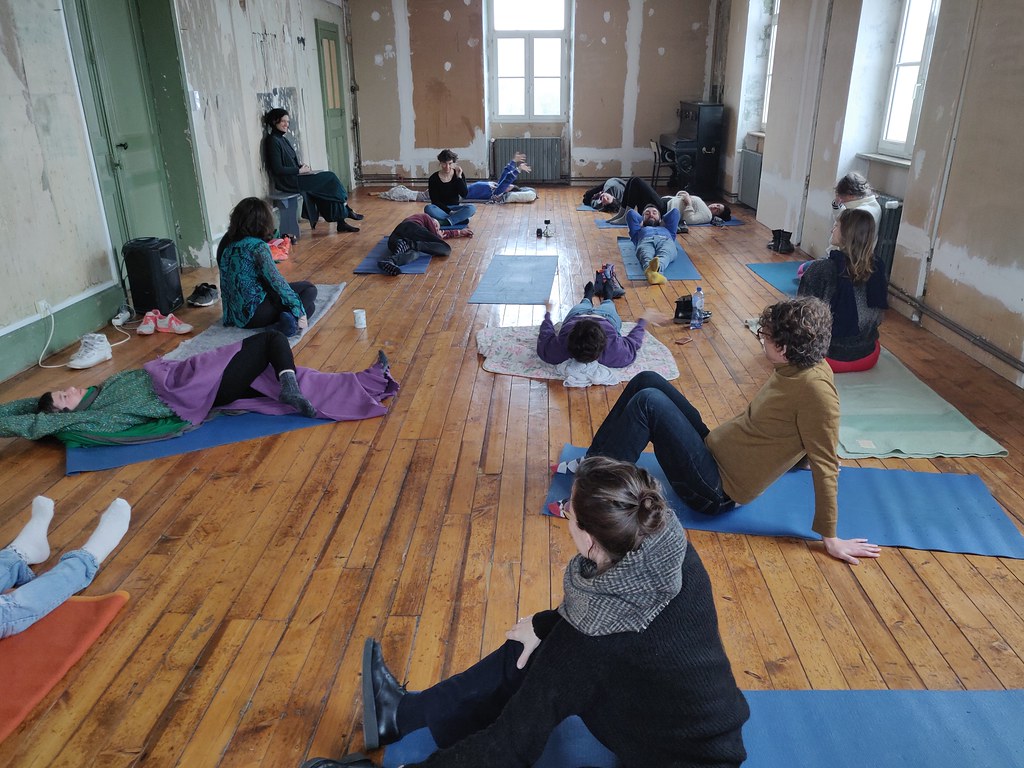
Personal backstory
A backstory is a set of events invented for a plot, presented as preceding and leading up to that plot. It is a literary device of a narrative history all chronologically earlier than the narrative of primary interest. (…) It is the history of characters and other elements that underlie the situation existing at the main narrative's start. From: https://en.wikipedia.org/wiki/Backstory
The backstory can be created for the scenario as a whole. At the Art of Futuring Workshop each participant worked on developing a personal backstory (as a written exercise), by asking themselves How would I get from here to there? (“there” being the future described in the scenario) and What might my life look like in 5, 10, 15 years, if the future was heading towards the scenario?
The purpose of writing out a personal backstory is to make the scenario more concrete for the participants' lives. By having to think what would have to happen to them to get to such a scenario helps ground what is essentially speculative fiction into the real life of real people.
Prototyping
Talking and writing stories about the future can be made more tangible and accessible by using drawings, images and other (audio)visual media, physical objects and artefacts. The creed “Use a picture. It’s worth a thousand words” applies to futures too. An image can convey an atmosphere of a future at a glance; a video can tell its story in a few minutes; an object can add a tactile, perhaps even olfactory or gustatory dimension.
Design fiction has popularised making futures tangible by creating 'objects from the future' that are recognisable, yet strangely unfamiliar, raising questions and enabling critical discussions about futures in the present. Futures prototyping techniques borrow from the arts, design, film-making and other creative practices that have well-established methods to imagine possible worlds and bring them to life in different forms.
Physical prototyping can be as simple as a design exercise, but it can also be as elaborated as whole immersive environments. You can read more about this approach in Making Things Physical.
Physical narrative (PN) can be described as a theatre without actors, where spectators become engaged visitors, playfully discovering futures by experiencing physical spaces, objects and media. A PN is an explorable world, rather than a singular story. PNs take the form of immersive installations where entangled fragments of scenarios can be experienced through all the senses as a self-contained, aesthetically coherent reality. Direct experience of scenarios presented as physical prototypes can engage visitors with alternatives to the status quo, and suggests that futures can be proactively influenced by all. -Time's Up & FoAM
At the Art of Futuring workshop we used the following prototyping techniques:
Personal profile page
One of the scenario axes at the Art of Futuring Workshop was looking at (de)centralisation of social media. This exercise was designed to apply an important element of scenario logic (alternative futures of social media) to a phenomenon that is familiar to all participant, such as a personal profile page. In designing such a page from the vantage point of different scenarios, the participants were invited to think about its content and format; about things that they would share about themselves in different futures, etc.
Postcards from the future
To embody elements of the scenarios, we created “Tableau Vivants” at the Art of Futuring workshop. They were collective photographs that would “appear on the profile pages” of the participants.
A tableau vivant (…) is a static scene containing one or more actors or models. They are stationary and silent, usually in costume, carefully posed, with props and/or scenery, and may be theatrically lit. It thus combines aspects of theatre and the visual arts.
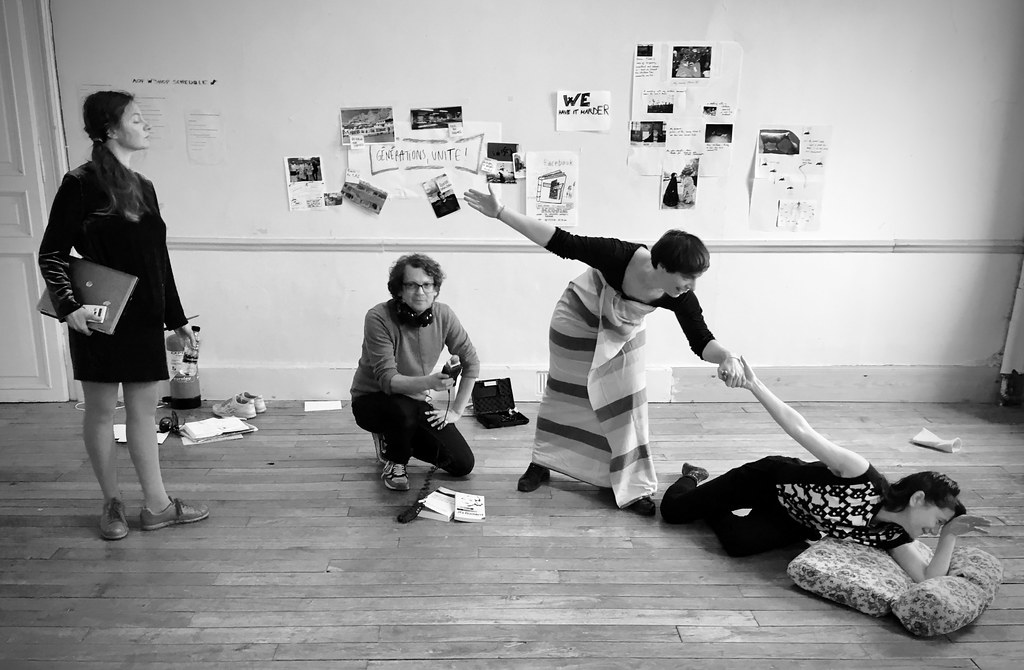
Preferred futures
Aside from working with multiple, alternative futures, there are techniques that work with preferred futures, and help us understand their relationship with the past and present.
Appreciative Inquiry
Appreciative Inquiry (AI) is a method that focuses on creating preferred futures starting from the strengths, successes and unique attributes of a system or a group in the past and present. AI is grounded in a belief that in any situation there is something that works well. From this position of appreciation, it encourages the participants to discover their aspirations, desires and images of futures they would like to see.
At the Art of Futuring Workshop we explored the discovery phase of appreciative inquiry. Read more about appreciative inquiry here.
Backcasting
Backcasting is a planning method that starts with defining a desirable future and then works backwards to identify policies and programs that will connect that specified future to the present. (…) The fundamental question of backcasting asks: “if we want to attain a certain goal, what actions must be taken to get there?” https://en.wikipedia.org/wiki/Backcasting
TOC Outcomes Framework
At the Art of futuring workshop we used the Theory of Change Outcomes Framework to experiment with backcasting.
Read more about TOC Outcomes Framework here.
Prehearsal
A prehearsal is an improvised situation of short duration, a try-out of a scenario focusing on the player’s behaviours and interactions, using minimal props and setup. The prehearsed situation should be familiar enough to the participants, so they can focus on the content rather than the form of the prehearsal. The difference between role playing and a prehearsal is that the participants do not assume the role of another character, but play themselves in different situations.
The general purpose of futures studies could be regarded as the provision of tools for the invention and pursuit of preferred futures; that is, the reconciliation of hopes and expectations. But it begins and ends, finally, with what any individual does in relation to those things. (…) [It is] the most potent political tool, to enable people to systematically redistribute the sensible at will and on their own behalf. (…) development and spread of futures tools rather than the outcomes of their application [is our concern]. —Stuart Candy, The Futures of Everyday Life
Read more about the steps of designing a prehearsal here.
At the Art of Futuring Workshop we only had one (optional) session where the participants were invited to design a prehearsal, but we did not get a chance to enact it. The participants developed a more elaborate plan than a simple prehearsal. They designed a “pre-enactment”.
Pre-enactment
Pre-enactments are inspired by large-scale larps and re-enactments, but rather than enacting an historical or fictional situation, the participants preenact a situation that may exist in their future. During a pre-enactment, a scenario comes to life as a “first-person experience”. Participants can explore what their life might be like in a specific possible future. In order for the experience to be believable, the broad strokes of a scenario need to be filled with the mundane details of daily life, which can include things like food, clothing, tools, work-spaces, interfaces, events, rituals, etc. Elaborating an experience in such detail can help point to inconsistencies between the ideas in the scenario and the gritty reality, between the images of the future and their embodied manifestations.
Read more about pre-enactments here
Invocation
We started the Art of Futuring Workshop with divination, an ancient technique to probe the unknown futures. We ended it with another one: invocation.
Once you’ve created some wiggle room in the present and explored some of the adjacent possible, you might want some of these possibilities to become manifest. How do you help the possibilities to materialise in the present? Most worldviews and belief systems have ways of invoking the spectral possible. A prayer to St. Anthony might help with a lost set of keys. At life’s many crossroads, turn to Hecate or Papa Legba. At any moment you might make an offering to Green Tara for protection and White Tara for good health. When in need of prosperity or success in business, best ask Lakshmi and Ganesh. Alternatively, follow the predictions of stock-market gurus or the black art of economics. While the specific deities and invocation methods may differ, they all provide ways of focusing attention and framing intent. This is important, because attention helps clarify intent, and intent helps bind anticipation to action. It prepares the mind, and prepares the body. “In the fields of observation” says Louis Pasteur “chance favours only the prepared mind.” (…) Anticipating change, hoping for change, or even fighting for change might not be enough. The idea of change itself might have to change. We need a hex for transforming transformation. “A poem to write on the face of reality”, with all the force of collective intent. -Maja Kuzmanovic & Nik Gaffney
At the Art of Futuring Workshop we invoked: one thing for yourself, one for the group and one for all beings. We used our voices and bodies to project our intent into the space, hoping to invoke these realities into being…
Process facilitation
Imagine a future where the most revolutionary changes in our world have not come from nanotech, genetic engineering, artificial intelligence or even space development–but from cognitive science and a deepening understanding of how humans function (or not) in groups. What would such a future look like? —Karl Schroeder in Rewilding Etiquette
While the Art of Futuring Workshop focused on future-oriented techniques, we also experimented with several process facilitation techniques that grounded our work in the present, with the people involved. If you are interested in guiding collective futuring processes, it helps to learn about process facilitation as well. You can find a few tips here
Here are a few techniques mentioned explicitly at the Art of Futuring Workshop
Asking questions
A powerful question is a three-dimensional one. The three dimensions are: construction, scope and assumptions. Construction is about phrasing of the question - which words you use can inspire people (e.g. questions starting with why, how and what (if)). The scope is about tailoring the question to the capacity of people's action - where can people make immediate difference (e.g. family, organisation, community, global society).
Every question will have your or wider assumptions built into it, assumptions that might not be shared in the group. We should be especially aware of negative assumptions (“what did we do wrong?” could be better phrased as “what can we learn from what happened?”). Having a question focus on the problem, can make people defensive or disengaged. It's helpful to check if the question encourages learning, reflection, collaboration and/or exploration rather than blaming, competition or justifying.
Read more about The art of powerful questions here: https://www.scribd.com/document/18675626/Art-of-Powerful-Questions
Dot-voting
Dot-voting is a facilitation method used to describe voting with dot stickers or markers. Dot-voting is widely used for making quick collaborative decisions. It is a quick and simple method for prioritize a long list of options.
Read more about dot-voting here: http://dotmocracy.org/dot-voting/
Sociometry
Sociometry is a technique to visualise social relationships. It can show underlying patterns of a group which can be difficult to surface through conversation. A sociometric exercise begins with a question that the group is required to answer by moving in the space and finding appropriate positions for all its members relative to each other.
Read more about sociometry here.
See also the website of the Sociometry Training Network: http://www.sociometry.net/
Theory U
The Art of Futuring Workshop was designed with the flow of the Theory-U in mind. we explicitly mentioned the U-Process in relation to our post-lunch silent reflection, meant to allow the participants to return to themselves and integrate the insights and experiences with their inner-life.
We move down one side of the U (connecting us to the world that is outside of our institutional bubble) to the bottom of the U (connecting us to the world that emerges from within) and up the other side of the U (bringing forth the new into the world). On that journey, at the bottom of the U, lies an inner gate that requires us to drop everything that isn't essential. This process of letting-go (of our old ego and self) and letting-come (our highest future possibility: our Self) establishes a subtle connection to a deeper source of knowing. The essence of presencing is that these two selves - our current self and our best future Self - meet at the bottom of the U and begin to listen and resonate with each other. https://en.wikipedia.org/wiki/Theory_U
Open Space
Open Space Technology (OST) is a method for organizing and running a meeting or multi-day conference, where participants have been invited in order to focus on a specific, important task or purpose. OST is a participant-driven process whose agenda is created by people attending. https://en.wikipedia.org/wiki/Open_Space_Technology
At the Art of Futuring Workshop the participants were invited to design evening sessions. We didn't follow the formal OST Marketplace, but we used the open space principles and the participants got a chance to host sessions on their own. For example, one of the participants hosted a session that translated futuring and scenario ideas into a live DJ-set. The playlist can be found here. Another lead a hands-on torch making workshop and night walk.
Adaptive Action Cycle
At the end of the Art of Futuring Workshop we used the Adaptive Action Cycle. This feedback technique is designed for iterative processes which can benefit from periodic cycles of evaluation and adaptation. At the core of the technique are three seemingly simple questions: what, so what and now what.
Read more about this technique here

References
A few references:
- Future of The World, a recent book on the history of futures
- etc.
Interesting futurists and futures-oriented individuals and organisations, working close to the arts, design and culture:
- etc, etc.
A few references to FoAM's work with futures
- A Futurists' Fieldguide, editable collection of futuring techniques, methods and aptitudes
- Enacting Futures in Postnormal Times, a paper describing FoAM's approach to futures, including a chapter on prehearsals and pre-enactments
- Making Things Physical, article in collaboration with Time's Up about physical and alternate reality narratives in futures
- Future Fabulators, research notes on scenario building, experiential futures and other related topics collected during a specific project
- Books and articles at the FoAM Library collected for the Future Fictions exhibition in Z33

